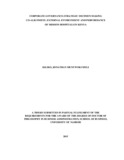| dc.description.abstract | This study was set to test the viability of the co-alignment model using theories that
support corporate governance practices and strategic decision-making dimensions and
their effect on performance. It interrogated the relationship between corporate
governance-strategic decision making co-alignment, external environment and
performance of Mission Hospitals in Kenya. Drawing from the agency, stakeholder,
resource-based view and open system theories, the researcher conceptualised the
potential effect of corporate governance-strategic decision making co-alignment on
performance. It was prompted by the need for more grounding since there are limited
empirical studies on co-alignment model and study context. Arising from the broad
objective, seven specific objectives were formulated and each of these objectives had a
corresponding hypothesis. A descriptive cross-sectional survey research design was used,
anchored on positivism philosophy. The target population consisted of 88 Mission
Hospitals in Kenya and data were collected from 74 hospitals (84.09 percent response
rate). A single data collection method through structured questionnaires was used. The
collected data was analysed and interpreted based on descriptive statistics, correlation and
multivariate regression analysis as well as canonical correlations analysis. The findings
revealed that corporate governance, strategic decision-making, corporate governancestrategic
decision making co-alignment and external environment had a significant joint
effect on the performance of Mission Hospitals in Kenya. The results further indicate that
there was significant moderating influence of the external environment on the
relationship between the independent variables and performance (the dependent variable).
Correlation and regression analysis indicated that there exist strong relationships among
the variables in the model. Indeed, results suggested that the joint effect of the
independent variables on dependent variables were statistically significant. This study has
made contributions to theory, policy, managerial practices and methodology. It has given
rise to several new research avenues and practical implications such as the need to
replicate this study in different contexts in order for researchers to draw patterns.
However, one of the limitations of this study was the single data collection method
through self-administered tool which could be biased and subjective in nature. The
reliance on primary data has potential danger associated with sources of systematic
measurement error. Future studies could focus on using secondary data to measure, for
example, both financial and non-financial performance. The researcher also employed a
cross sectional approach whereas a longitudinal approach would provide for a longer time
of study to observe relationships among study variables and to underscore the importance
of co-alignment in explaining superior organisational performance. | en_US |



